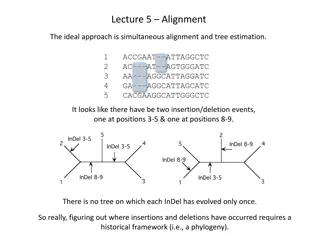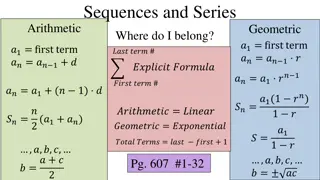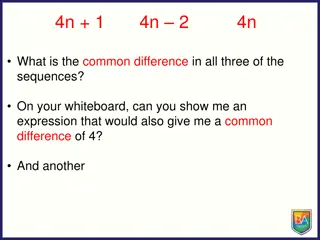Understanding Sequences and Series in Precalculus
Embark on a journey through the fundamentals of sequences and series in Precalculus as presented in Richard Wright's textbook. Explore various examples and diagrams to enhance your comprehension of this essential mathematical concept.
Download Presentation

Please find below an Image/Link to download the presentation.
The content on the website is provided AS IS for your information and personal use only. It may not be sold, licensed, or shared on other websites without obtaining consent from the author. Download presentation by click this link. If you encounter any issues during the download, it is possible that the publisher has removed the file from their server.
E N D
Presentation Transcript
SEQUENCES AND SERIES 1 Precalculus Chapter 10
This Slideshow was developed to accompany the textbook Precalculus By Richard Wright https://www.andrews.edu/~rwright/Precalculus-RLW/Text/TOC.html Some examples and diagrams are taken from the textbook. Slides created by Richard Wright, Andrews Academy rwright@andrews.edu
10-01 SEQUENCES 3 In this section, you will: Write a sequence from a rule. Write an explicit rule for a sequence. Write a recursive rule for a sequence. Simplify factorial expressions.
10-01 SEQUENCES Sequence List of numbers following a rule 0, 3, 6, 9, 12 < finite (ends) 0, 3, 6, 9, 12, < infinite (doesn t end) ? = 1,2,3,4,5, (term #) like x ??= 0,3,6,9,12, (term value) like y 4
10-01 SEQUENCES Find the 1st 5 terms of ??= 5 + 2? 1? 5
10-01 SEQUENCES Write the rule for the nth term. 1, 5, 9, 13, 17, 2, -9, 28, -65, 126, 6
10-01 SEQUENCES Recursive Rules Use the value of one term to find the next term. Find the first 5 terms. ?1= 6 ??= ?? 1+ 1 ?? means current term ?? 1 means previous term 7
10-01 SEQUENCES Factorial (!) Product of a whole number with all the whole numbers less than it through 1. 6! = 6 5 4 3 2 1 5! = 5 4 3 2 1 0! = 1 Simplify 9! 3!7! 8
10-01 SEQUENCES Simplify ?+1 ! ?! 9
10-02 SERIES 10 In this section, you will: Evaluate a summation. Write a series as a summation.
10-02 SERIES Series Sum of a sequence Summation Notation (Sigma Notation) ? Sequence 2, 4, 6, 8 Series 2 + 4 + 6 + 8 ??= ?1+ ?2+ ?3+ + ?? ?=1 11
10-02 SERIES 5 Find each sum 4 2 + ?3 (4? + 1) ?=2 ?=1 12
10-02 SERIES 5 10? ?=1 13
10-02 SERIES Shortcut formulas ? 1 + 1 + 1 + 1 + = 1 = ? ?=1 ? =? ? + 1 ? 1 + 2 + 3 + 4 + = 2 ?=1 ?2=? ? + 1 2? + 1 ? 1 + 4 + 9 + 16 + = 6 ?=1 14
10-02 SERIES ? ?3=?2? + 12 1 + 8 + 27 + 64 + = 4 ?=1 ? ?4=? ? + 1 2? + 1 3?2+ 3? 1 1 + 16 + 81 + 256 + = 30 ?=1 ? ?5=?2? + 122?2+ 2? 1 1 + 32 + 243 + 1024 + = 12 ?=1 15
10-02 SERIES Evaluate 5 3?2 5? ?=1 16
10-03 ARITHMETIC SEQUENCES AND SERIES 17 In this section, you will: Write the explicit rule for an arithmetic sequence. Write the recursive rule for an arithmetic sequence. Evaluate the sum for an arithmetic series.
10-03 ARITHMETIC SEQUENCES AND SERIES Arithmetic Common difference (d) Rule for the nth term ??= ?? + ? Where ? = ?1 ? 3, 7, 11, 15, 19, ??= ?1+ ? 1 ? 18
10-03 ARITHMETIC SEQUENCES AND SERIES Find the rule for the nthterm for 3, 7, 11, 15, 19, 19
10-03 ARITHMETIC SEQUENCES AND SERIES The 8th term of an arithmetic sequence is 25, and the 12th term is 41. Write the rule for the nth term. 20
10-03 ARITHMETIC SEQUENCES AND SERIES Recursive Rule for Arithmetic Sequences ?1= ?1 ??= ?? 1+ ? 21
10-03 ARITHMETIC SEQUENCES AND SERIES Arithmetic Series 1 + 3 + 5 + 7 + 9 + 11 + 13 + 15 + 17 + 19 1 + 3 + 5 + 7 + 9 19 + 17 + 15 + 13 + 11 20 + 20 + 20 + 20 + 20 = 5 20 = 100 ??=? 2?1+ ?? 22
10-03 ARITHMETIC SEQUENCES AND SERIES Find the sum of the integers 1 to 57. 23
10-03 ARITHMETIC SEQUENCES AND SERIES Find the 50th partial sum of the arithmetic sequence -6, -2, 2, 6, 24
10-03 ARITHMETIC SEQUENCES AND SERIES Evaluate 100 (3? + 2) ?=1 25
10-04 GEOMETRIC SEQUENCES AND SERIES 26 In this section, you will: Write the explicit rule for a geometric sequence. Write the recursive rule for a geometric sequence. Evaluate the sum for a geometric series.
10-04 GEOMETRIC SEQUENCES AND SERIES Geometric Common ratio (r) Find the rule for 6, 2,2 3, 1, 3, 9, 27, 81, 243, Rule for nth term ??= ?1?? 1 27
10-04 GEOMETRIC SEQUENCES AND SERIES The 2nd term of a geometric sequence is -18, the 5th term is 2/3. Find the rule for the nth term. 28
10-04 GEOMETRIC SEQUENCES AND SERIES Geometric Series Evaluate 7 2? 1 1 ?? 1 ? ??= ?1 ?=1 ?1 1 ? ? = Where ? < 1 29
10-04 GEOMETRIC SEQUENCES AND SERIES ? Evaluate 5 + 0.5 + 0.05 + 0.005 + 1 2 5 ?=0 30
10-05 MATHEMATICAL INDUCTION 31 In this section, you will: Write a proof for a sum formula using mathematical induction. Prove other mathematical statements using mathematical induction.
10-05 MATHEMATICAL INDUCTION Proofs for sum formulas Show it works when n = 1 Show it works for n + 1 Steps 1. Show it works for n = 1 2. Assume formula works for ? = ? 3. Show it works for ? = ? + 1 If proving sum formula use ??+1= ??+ ??+1 32
10-05 MATHEMATICAL INDUCTION Prove 5 + 7 + 9 + 11 + 13 + + 3 + 2? = ? ? + 4 33
10-05 MATHEMATICAL INDUCTION Prove 1 1 1 + 2 2 1 + 3 3 1 + + ? ? 1 =? ? 1 ?+1 3 34
10-05 MATHEMATICAL INDUCTION Prove ? + 1 ! > 2? where ? 2 35
10-05 MATHEMATICAL INDUCTION Prove 4 is a factor of 5? 1 36
10-06 BINOMIAL THEOREM 37 In this section, you will: Evaluate combinations. Expand binomial expressions.
10-06 BINOMIAL THEOREM (x + y)0 1 (x + y)1 1x 1y (x + y)2 1x2 2xy 1y2 (x + y)3 1x3 3x2y 3xy2 1y3 (x + y)4 1x4 4x3y 6x2y2 4xy3 1y4 Properties 1. n + 1 terms 2. Powers of x count down, y s count up 3. Sum of exponents of each term = n 4. Coefficients are symmetrical ??? 38
10-06 BINOMIAL THEOREM Binomial theorem ? 11 ? + ??= ????? ??? 4 ?=0 ?! Where ???= 8 ? ? !?! 8 Evaluate 4 9?2 2 39
10-06 BINOMIAL THEOREM Expand ? + 24 40
10-06 BINOMIAL THEOREM Expand 3 ?2 5 41
10-06 BINOMIAL THEOREM Find the coefficient of the term ?4?7 in 2? 3?11 42
10-07 COUNTING PRINCIPLES 43 In this section, you will: Apply the fundamental counting principle Calculate permutations Calculate combinations
10-07 COUNTING PRINCIPLES Fundamental Counting Principle If events E1 and E2 occur in m1 and m2 ways, the number of ways both events can occur is m1 m2. A lock will open with the right choice of 3 numbers. How many different sets of 3 numbers can you choose if each number is from 1 to 30 inclusive? (a) with repetition (b) without repetition 44
10-07 COUNTING PRINCIPLES How many license plates can be made if each is 2 letters follow by 4- digits? (a) with repetition (b) without repetition 45
10-07 COUNTING PRINCIPLES Permutation Number of ways to ordern objects taken r at a time ?! ? ? ! ???= How many ways can 8 children line up in a row? 46
10-07 COUNTING PRINCIPLES A club has 24 members, how many ways can 5 officers be selected? 47
10-07 COUNTING PRINCIPLES Distinguishable Permutations What is some objects are exactly the same? ABB BAB and BAB are the same eventhough the B s were switched We want the orders that look different (choosing all the objects) ?! ?1! ?2! ?3! Where n = number of objects; q = how many times each is repeated 48
10-07 COUNTING PRINCIPLES How many distinguishable ways to order the letters in BANANA? 49
10-07 COUNTING PRINCIPLES Combinations Grouping of objects without order ABC is the same as BAC ?! ???= ? ? !?! There are 31 students. How many different groups of 4 can be made? 50























